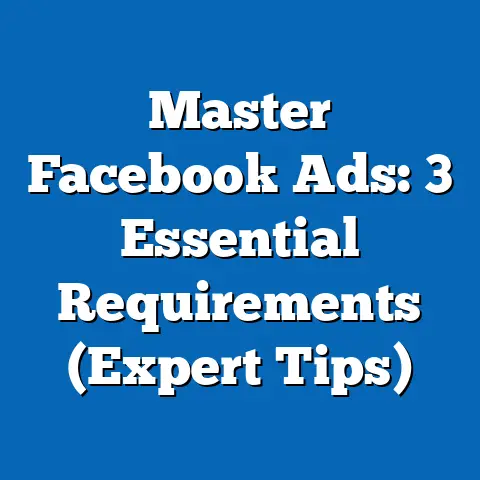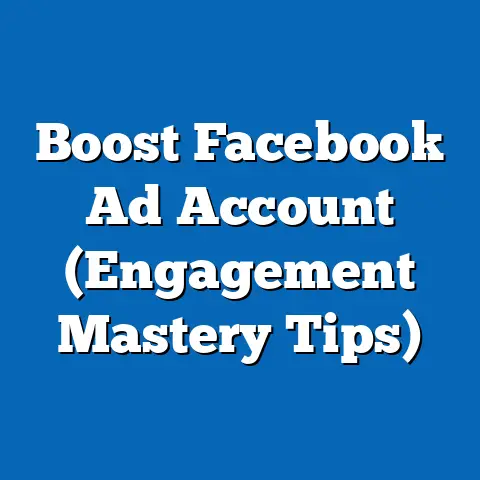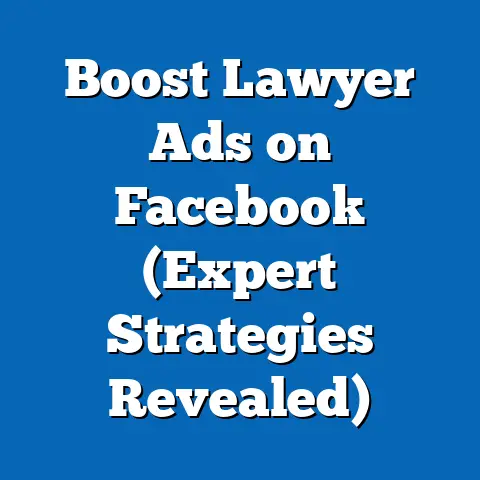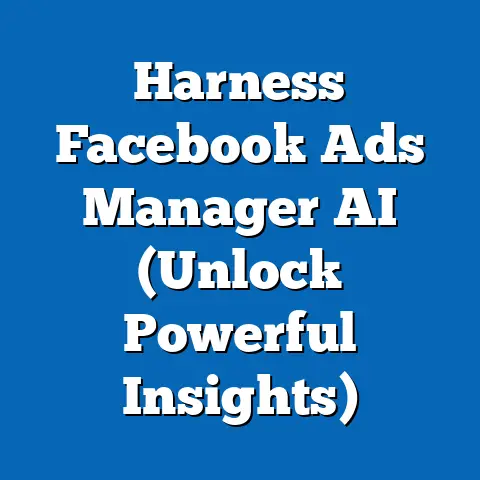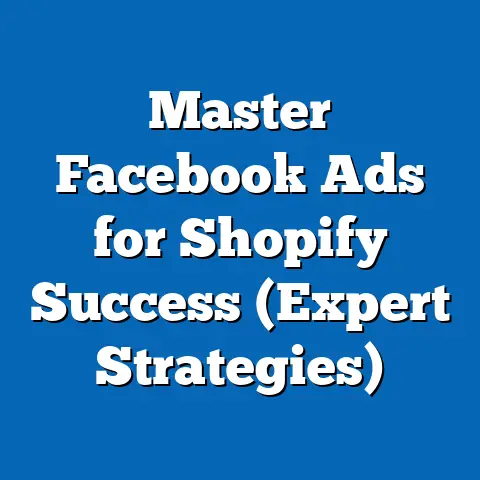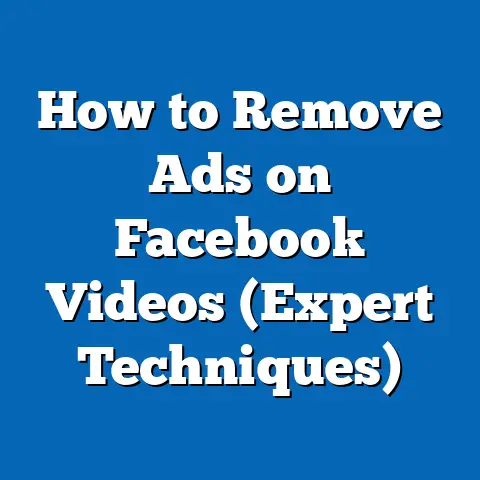Master Facebook Ads Headline Limits (Unlock Performance Secrets)
Have you ever walked into a room and immediately felt overwhelmed by the clutter? It’s tough to focus, right? It’s the same with Facebook ads. A cluttered, confusing ad can be just as off-putting to potential customers. Just like a clean, organized space boosts productivity, a well-structured Facebook ad, especially the headline, can dramatically improve your campaign’s performance.
The headline is the first (and sometimes only) thing people see. It’s your chance to grab their attention, set clear expectations, and entice them to learn more. But here’s the catch: Facebook, now Meta, has headline character limits. And mastering those limits is where the real magic happens. In this article, I’m going to pull back the curtain and reveal the performance secrets hidden within those seemingly restrictive boundaries. I’ll show you how to craft headlines that not only fit the rules but also pack a powerful punch, driving engagement and conversions. Let’s dive in!
Understanding Facebook Ads Headline Limits
Okay, so what exactly are these headline limits everyone keeps talking about? Simply put, they’re character restrictions Facebook (Meta) places on your ad headlines. These limits are designed to keep the platform clean, user-friendly, and prevent advertisers from overwhelming users with overly long or spammy messages.
The exact character count can vary depending on the specific ad placement and type. For example, a single image or video ad might have a slightly different headline limit than a carousel ad. As of my last update, you generally want to aim for around 25-40 characters to ensure your headline displays fully on most devices. However, always check the Facebook Ads Manager specifications for the most up-to-date guidelines, as these can change.
Why is sticking to these limits so important? Well, exceeding them can lead to a few undesirable outcomes:
- Ad Disapproval: Facebook might simply reject your ad if the headline is too long. This means wasted time and effort.
- Truncated Headlines: Even if your ad is approved, long headlines often get cut off with an ellipsis (“…”), making your message incomplete and less appealing. Imagine a headline saying, “Get 50% Off All Shoes…” – it leaves the user hanging!
- Decreased Visibility: Facebook’s algorithm prioritizes user experience. Ads with truncated or poorly formatted headlines might be shown to fewer people.
Takeaway: Know your limits! Before you even start brainstorming headlines, check the current Facebook Ads Manager specifications for the ad type you’re using.
The Psychology Behind Headlines
Now, let’s get into the fascinating world of psychology. Headlines aren’t just about fitting within a character limit; they’re about tapping into the human mind. A great headline speaks directly to the reader’s needs, desires, and pain points. It’s the first step in building a connection and guiding them towards your desired action.
Here are a few key psychological principles to keep in mind when crafting your headlines:
- Curiosity: Humans are naturally curious. A headline that piques curiosity will encourage people to click. Think about headlines like, “The One Trick Doctors Don’t Want You to Know…” – it’s intriguing!
- Urgency: Creating a sense of urgency can motivate immediate action. Phrases like “Limited Time Offer,” “Sale Ends Tonight,” or “Don’t Miss Out” can be highly effective.
- Emotional Triggers: Appealing to emotions like happiness, fear, excitement, or anger can create a strong connection with your audience. A headline like, “Finally! A Solution to Your Sleepless Nights” speaks directly to a specific pain point.
- Social Proof: People are more likely to take action if they see others doing the same. Headlines that mention testimonials, reviews, or the number of satisfied customers can build trust and credibility. “Join 10,000+ Happy Customers” is a classic example.
My Experience: I once ran an ad campaign for a local bakery. Initially, our headlines were pretty generic, like “Best Pastries in Town.” We weren’t seeing great results. Then, we started experimenting with emotional triggers. One headline, “Indulge Your Sweet Tooth Today! (You Deserve It!),” saw a significant increase in click-through rates. It turns out, people are often looking for an excuse to treat themselves!
Takeaway: Think like your customer. What are their needs, desires, and pain points? How can you craft a headline that speaks directly to them on an emotional level?
How do you squeeze all that psychological power into a tiny headline? Here are some actionable strategies I’ve found to be incredibly effective:Utilize Power Words: Power words are persuasive words that evoke emotions or actions. They can make your headline more compelling and encourage clicks. Some examples include:
- Action-oriented: Discover, Get, Learn, Try, Start
- Benefit-driven: Free, Easy, Proven, Guaranteed, Best
- Emotional: Secret, Shocking, Amazing, Incredible
For instance, instead of “New Marketing Guide,” try “Discover the Secret to Explosive Marketing Growth.”
Ask a Question: Questions can be a great way to pique curiosity and engage your audience. Make sure the question is relevant to their needs and that your ad provides a compelling answer. For example, “Struggling to Lose Weight? We Can Help!”
Use Numbers and Statistics: Numbers and statistics can add credibility and make your headline more attention-grabbing. “5 Proven Strategies for Increasing Website Traffic” or “90% of Our Customers See Results in 30 Days” are good examples.
Test Variations (A/B Testing): This is crucial! You can’t know for sure what headlines will resonate with your audience until you test them. Use Facebook’s A/B testing feature to run multiple versions of your ad with different headlines and see which performs best.
Utilize Power Words: Power words are persuasive words that evoke emotions or actions. They can make your headline more compelling and encourage clicks. Some examples include:
- Action-oriented: Discover, Get, Learn, Try, Start
- Benefit-driven: Free, Easy, Proven, Guaranteed, Best
- Emotional: Secret, Shocking, Amazing, Incredible
For instance, instead of “New Marketing Guide,” try “Discover the Secret to Explosive Marketing Growth.”
Ask a Question: Questions can be a great way to pique curiosity and engage your audience. Make sure the question is relevant to their needs and that your ad provides a compelling answer. For example, “Struggling to Lose Weight? We Can Help!”
Use Numbers and Statistics: Numbers and statistics can add credibility and make your headline more attention-grabbing. “5 Proven Strategies for Increasing Website Traffic” or “90% of Our Customers See Results in 30 Days” are good examples.
Test Variations (A/B Testing): This is crucial! You can’t know for sure what headlines will resonate with your audience until you test them. Use Facebook’s A/B testing feature to run multiple versions of your ad with different headlines and see which performs best.
My Experience: I was working with a client selling online courses. We tested two headlines: “Learn Digital Marketing” and “Master Digital Marketing in 30 Days.” The second headline, which included a specific timeframe and a stronger power word (“Master”), outperformed the first by a significant margin. A/B testing is a game-changer!
Takeaway: Experiment, experiment, experiment! Don’t be afraid to try different headlines and see what works best for your specific audience and offer.
Analyzing Successful Facebook Ads Headlines
Let’s look at some real-world examples of successful Facebook ads and break down what makes their headlines so effective.
Example 1: Grammarly
- Headline: “Great Writing, Simplified.”
- Analysis: This headline is incredibly clear, concise, and benefit-driven. It immediately communicates the value proposition of Grammarly – helping people write better. The word “Simplified” adds to the appeal.
- Why it Works: It targets a broad audience (anyone who writes) and offers a simple solution to a common problem.
Example 2: Shopify
- Headline: “Start Your Free Trial Today!”
- Analysis: This headline uses urgency and a clear call to action. “Free Trial” is a powerful incentive, and “Today!” encourages immediate action.
- Why it Works: It removes the barrier to entry (it’s free) and motivates people to sign up now.
Example 3: Monday.com
- Headline: “Manage Your Team’s Work in One Place.”
- Analysis: This headline is straightforward and highlights a key benefit of using Monday.com – centralized team management.
- Why it Works: It targets project managers and team leaders who are looking for a better way to organize their work.
Key Takeaways from These Examples:
- Clarity is paramount: Successful headlines are easy to understand at a glance.
- Focus on benefits: Highlight the value your product or service provides.
- Use a strong call to action: Tell people what you want them to do.
My Insight: I’ve noticed that many successful Facebook ads headlines are surprisingly simple. They don’t try to be too clever or creative. Instead, they focus on delivering a clear and compelling message that resonates with the target audience.
Takeaway: Don’t overthink it! Sometimes the simplest headlines are the most effective.
Tools and Resources for Headline Optimization
Fortunately, you don’t have to rely solely on your own creativity to craft killer Facebook ad headlines. There are a number of tools and resources available to help you:
- Headline Analyzers: These tools evaluate your headlines based on various factors, such as length, emotional impact, readability, and SEO potential. Some popular options include CoSchedule Headline Analyzer and Sharethrough Headline Analyzer. They provide a score and suggestions for improvement.
- Facebook Ads Manager: Facebook’s own Ads Manager offers valuable insights into ad performance metrics. You can track click-through rates, conversion rates, and other key metrics to see which headlines are performing best. Use this data to refine your headline strategy.
- Google Keyword Planner: This tool can help you research relevant keywords for your target audience and incorporate them into your headlines.
- Ad Management Platforms: Platforms like Hootsuite Ads or AdEspresso can provide more advanced ad management and reporting features, including insights into headline performance.
My Recommendation: I highly recommend using a headline analyzer to get a quick assessment of your headline’s potential. It’s a great way to identify areas for improvement and ensure that your headline is optimized for engagement.
Takeaway: Leverage the tools and resources available to you to streamline the headline creation process and improve your results.
Conclusion
Mastering Facebook ads headline limits is not just about following rules; it’s about unlocking performance secrets. By understanding the psychological principles behind effective headlines, implementing proven strategies, analyzing successful examples, and leveraging helpful tools, you can craft headlines that capture attention, drive engagement, and ultimately, boost your campaign’s success.
Don’t underestimate the power of a well-crafted headline. It’s the first impression you make on potential customers, and it can be the difference between a successful campaign and a wasted budget. So, take the time to learn, experiment, and optimize your headlines. The results will be well worth the effort. Now, go out there and create some headlines that make an impact! I’m confident that by applying these strategies, you’ll see a significant improvement in your Facebook ad performance. Good luck!

